The State of Small Business Advertising in 2019

The State of Small Business Advertising in 2019
Nearly all small businesses advertise in some way. Digital advertising mediums are most popular, but traditional advertising such as TV, print, and radio are still important for small businesses.
Advertisements influence 90% of people to make a purchase, but is advertising a strategy that mainly benefits large businesses?
The Manifest surveyed 529 small business owners and managers at companies in the U.S. about their advertising habits, including which mediums they use and their plans for advertising in 2019.
We define small businesses as having limited revenue and between 1 and 500 employees, which corresponds to the Small Business Administration's definition of small business.
Advertising isn’t just a strategy for large businesses – small businesses benefit from it, too.
Small businesses can use this report to shape their advertising strategies.
Our Findings
- Nearly all small businesses advertise (87%).
- Small businesses advertise on a variety of mediums, but social media (64%) and online (49%) are the most popular.
- Small businesses still advertise on traditional mediums: print (36%), TV (22%), and radio (22%).
- Millennial-owned or -managed small businesses (95%) are more likely to advertise than those owned or managed by Generation Xers (92%) or baby boomers (70%).
- Small businesses owned or managed by millennials tend to advertise on more mediums than older generations.
- More than one-third of small businesses (34%) use event advertising.
- Facebook (86%) is the most popular social media channel that small businesses use to advertise, followed by YouTube (51%), Instagram (47%), and Twitter (41%).
- More than half of small businesses (53%) invest in Google search advertising.
- Two-thirds of small businesses (67%) plan to begin using at least one advertising medium in 2019.
Nearly All Small Businesses Advertise
Small businesses value advertising: Nearly all (87%) advertise in some form.

Advertising helps small businesses scale and reach potential customers.
“It’s essential for small businesses to advertise to not only maintain the level of business they have today but to grow,” said Harry Chapin, CEO and founder of Forge Worldwide, a brand-building company in Boston. “Very few businesses have the ability to attract new customers and grow revenues without advertising.”
Small businesses capitalize on the opportunity to grow their customer base and keep up with their competition through advertising.
Utility, a mobile app developer in New York City, advertises so potential customers remember the company when it comes time to hire a developer.
“Selling anything always requires multiple touchpoints,” said Utility’s Vice President of Growth Nishank Khanna. “Before your brain wants to buy a can of Coke, you have likely seen it on a billboard while driving, then an ad on TV, and read it in an article. The multiple touchpoints re-enforce a prospect’s subconscious that your brand exists and has a solution to what they want.”
Multiple touchpoints re-enforce a prospect’s subconscious that your brand exists and has a solution to what they want.
Utility advertises on multiple mediums to reach the most customers and establish a memorable impression.

Consumers who encounter a company on multiple mediums are more likely to remember the company when making purchasing decisions.
Small Businesses Are Most Likely to Advertise on Digital Mediums
Small businesses use digital advertising channels more than traditional channels.
Small businesses advertise on social media (64%) and online (49%) over traditional platforms such as print (36%) and TV (22%).

Small businesses that have limited resources use digital advertising to target customers who are the most likely to be interested in what they offer.
“Digital can be most effective because it can be so targeted, especially if you just have one location or a product for a very particular niche,” said Dan Collins, chief strategy officer at GKV, a full-service digital agency in Baltimore. “You’re not just getting everybody who’s watching ‘Grey’s Anatomy’ or another TV show. You’re getting people who are actually interested in your product.”
Digital advertising helps small businesses reach people who are interested in their products, whereas traditional advertising reaches broader demographics.
Curate.co, a management software platform for event professionals, focuses all its advertising efforts online to reach its target audience.
For example, its Facebook advertisements only reach those in the event planning industry, such as florists, caterers, and rental companies.
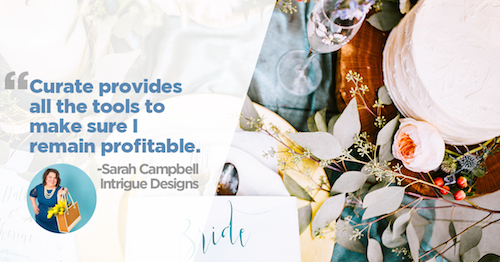
“We’re in a very niche market, so you have to go where the fish are,” founder Ryan O’Neil said. “Traditional mediums are unable to allow me to specify who I’m marketing to.”
Advertising online helps Curate.co spend its limited advertising budget to reach only people who are interested in its platform.
Digital advertising is a budget-friendly advertising strategy that makes it easy to target the most relevant audiences.
Figuring out which advertising medium to use may be challenging for small businesses, so many business owners rely on advertising agencies to help them determine which mediums work for their business.
Traditional Advertising Is Still Important for Small Businesses
Many small businesses still benefit from advertising on traditional mediums.
More than half (57%) of small businesses use traditional advertising mediums such as print, TV, radio, and out-of-home (OOH).

Traditional advertising is still more familiar than online advertising, which makes people trust it more.
“Print, TV, and radio have been around so long that there is an innate trust factor for a lot of people,” said Josh Ryther, senior partner at Deksia, a marketing strategy and brand development agency in Michigan. “It takes more to produce advertising that’s TV, print, or radio – not just time but more people and more thought. On Facebook, I can click three times and run an ad with very little thought or strategy behind it.”
Although online advertising requires less effort and is more affordable, traditional advertising is still effective because it is more trustworthy.
In fact, consumers find TV, print, and radio advertising more trustworthy than online and social media.
Traditional advertising also reaches consumers when they’re not online.
“None of us really live in just one channel all the time,” Chapin said. “Consumers today toggle between their phone, computer, radio, podcasts, and TV – and they do it all on their schedule. We live in an omnichannel world.”
None of us really live in just one channel all the time. ... We live in an omnichannel world.
Traditional advertising engages consumers when they are not on the internet. It also helps reach the demographics who don’t spend as much time online.
For example, the Storyteller’s Cottage, a venue that hosts literary events for children and adults in Simsbury, Conn., uses traditional advertising to appeal to its older audience – both people who attend events and those who sign their children up for summer camps.

“We rely on advertising to explain what we offer to potential customers,” said owner Lisa Natcharian. “When we need to reach an older demographic, TV and print ads are the best method.”
Advertising on traditional channels helps the Storyteller’s Cottage reach people who may not spend much time online.
Traditional advertising is trustworthy and is helpful in appealing to an audience throughout their day.
Millennial-Owned Small Businesses Are Most Likely to Advertise
Younger generations tend to see more value in advertising.
Small businesses owned or managed by millennials (95%) and Generation Xers (92%) are more likely to advertise than those owned or managed by baby boomers (70%).

Millennials recognize that advertising helps their business appeal to potential customers quickly.
“Millennials are used to instant gratification, and advertising helps satisfy that need,” said Les Kollegian, CEO of Jacob Tyler, a brand experience agency in California. “We live in a world with constant engagement, and millennials are the forefront of that expectation. Advertising helps people find a product they’re looking for quickly.”
Millennial-owned businesses understand that advertising engages modern consumers by appealing to their need for instant gratification.
Many millennials see the importance of advertising – even with a small budget. This includes Lagerhead Cycleboats, an entertainment boat company in Florida owned by millennial Drew Johnson.
Lagerhead Cycleboats uses radio, print, and online advertising.
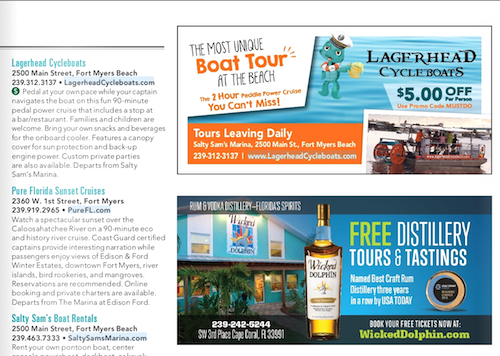
Lagerhead Cycleboats is less than two years old and relies on advertising to increase its brand awareness.
“In my opinion, expecting to grow your business without advertising is riskier than having a small marketing budget and potentially blowing it on bad advertising,” Johnson said. “Advertising is extremely important to our business. … In order for people to find out about us, we have to advertise.”
Most millennial-owned businesses are young, so millennials value advertising to spread word about their business.
Millennial-Owned Small Businesses Use More Advertising Mediums
Small businesses owned and managed by millennials are more likely to advertise on every advertising medium than older business owners – including TV.
Millennials are more likely to advertise on TV (41%) for their small business than Generation X (17%) and baby boomers (10%).

The younger generation is also more likely to advertise on the radio (38%) than Generation X (22%) and baby boomers (5%).
Millennials likely use more traditional mediums because older generations have already experimented with these mediums for their businesses.
“Older generations have tried traditional mediums and either had great returns and stuck with them or didn’t and abandoned them,” Ryther said. “Maybe the younger generation is still testing out these more traditional mediums and hasn’t experienced as much negative return, so they’re more willing to take more of a risk.”
Younger business owners are still testing traditional mediums to determine what type of advertising is right for their business. They are also more likely to advertise on online mediums because it’s where they spend much of their personal time.
“Millennials grew up online,” said Tim Smith, director of communications and media planning at IPNY. “To even reach them, you have to go online, and millennials understand that.”
Younger generations are more familiar with online and social media platforms, thus are more likely to advertise on them.
Helix, an online mattress retailer, advertises on multiple mediums, including social media, radio, and Google. The company is owned by three millennials.

Helix’s owners believe it's important to test advertisements on many channels.
“We strongly believe that a diversified advertising portfolio is critical [to] being successful as a new brand,” Helix co-founder Kristian von Rickenbach said. “We want to have a diversified mix so that we can test into new channels and constantly reallocate our budgets to where we see the best return.”
Advertising on different mediums helps Helix reach the most people possible and determine the most successful advertising channel for their business.
Millennials see the importance of advertising on a variety of mediums – both traditional and digital – and aren’t afraid to invest money in multiple to determine which ones work best for their business.
Event Advertising Helps Small Businesses Spread Brand Awareness
Event advertising helps small businesses raise brand awareness among niche audiences.
More than one-third of small businesses (34%) use event advertising.

Event advertising helps small businesses reach people in their niche, such as local runners.
“Event advertising makes sense for certain businesses to make people aware they exist,” Collins said. “For example, if you’re a running store in Baltimore or Washington, D.C., and there’s a race nearby, it certainly makes sense to advertise there.”
Event advertising reaches customers who are most likely interested in your product. For example, Charm City Run, a running apparel retailer with locations throughout Maryland, sponsors several local races throughout the year, such as the Under Armour Sole of the City 10K.
The race’s logo incorporates the Charm City Run logo, and the 10K ends at a Charm City Run location, which makes the retailer memorable for race participants.

Advertising at an event helps local retailers like Charm City Run reach niche customers who are likely to convert – such as buying running shoes after ending a race at a running store.
Event advertising helps businesses appeal to customers of a specific target audience.
Facebook Advertising Is Still Important to Small Businesses
Facebook isn’t dying. In fact, it’s still the most popular social media advertising channel for small businesses.
Eighty-six percent (86%) of small businesses that advertise on social media use Facebook – at least one-third more than those that advertise on YouTube (51%), Instagram (47%), or Twitter (41%).
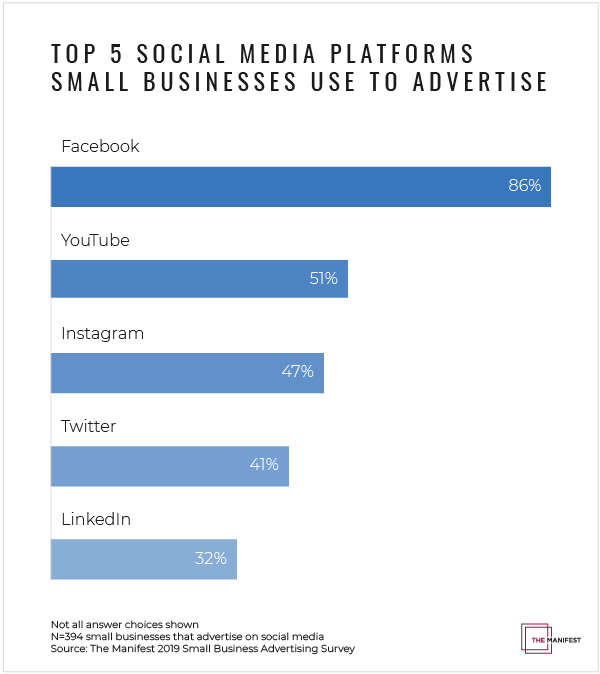
Facebook is the most popular social media advertising platform for small businesses because it is still the most popular social media channel for consumers.
“People say Facebook is dying, but by and large, it’s the biggest social platform in the world,” Smith said.
Facebook advertising works because it reaches more people than any other platform. The talks of it dying are premature.
Dan DeBaun, owner of water filter retailer Big Berkey Water Filters, values social media, especially Facebook, because of the word-of-mouth its advertisements create.

“[Facebook] has a high potential for sales conversions [based on] ideal demographics for our products,” DeBaun said. “Many of these converting customers go on to share our ads with family and friends post-purchase. This becomes free advertising … that is highly valuable to us.”
Using Facebook advertising helps businesses like Big Berkey Water Filters not only reach potential customers but have those customers spread the word of their brand.
Facebook also makes it easy for businesses to advertise.
“If you own a small business, you’re flooded with Facebook trying to get you to advertise,” Ryther said. “Two, three clicks, and I’m advertising on Facebook. It’s an easy thing to do.”
Small businesses don’t have to spend a lot of valuable time setting up advertisements for Facebook.
Businesses Favor Google Search Ads for Online Advertising
Google search is small businesses’ preferred online advertising channel.
More than half of small businesses that advertise online advertise on Google search (53%).
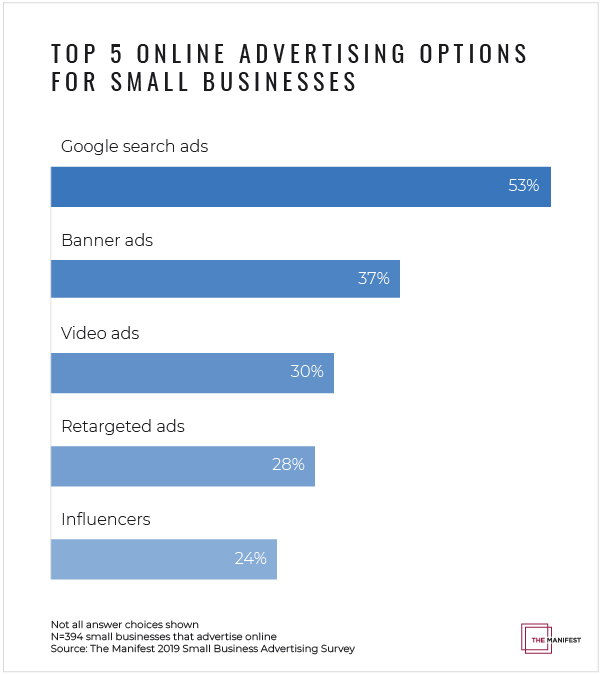
Businesses also use banner (37%), video (30%), retargeted (28%), influencer (24%), and native (24%) advertising.
Google ads are most popular because consumers turn to Google when shopping online.
“Search will always get a high percentage of the marketing budget because of its effectiveness in attracting customers who are actively searching for services or products similar to the ones you offer,” Chapin said. “That just reflects the way people shop and make purchasing decisions today.”
If consumers want a certain product, they are likely to start their search on Google. Small businesses that advertise on Google have a better chance of engaging these high-converting customers.
For example, Google advertising helps tent retailer Off Road Tents appeal to people shopping for specific products, such as a Front Runner Slimline Roof Rack.
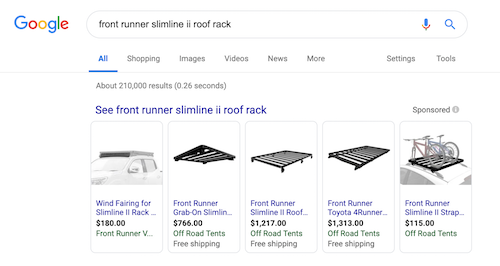
“Google can be a cheap and frankly outstanding platform for established products, as it will attract buyers [who] are further down the customer funnel,” Off Road Tents Advertising Manager Gianluca Boncompagni said. “For example, if you sell an established brand such as Front Runner, the person will search for it on Google and access Shopping Ads and look exactly for the product they’re after.”
Google advertising helps Off Road Tents reach shoppers who know what they want.
It’s also easy for businesses to track the success of their Google advertising.
“We can see precisely when a click converts to a sale, what ads are performing the best, and track our ROI in real time,” said Lewis Peters, digital marketing specialist at Online Turf, a turf retailer. “This insight enables us to see where our clicks are coming from and make informed decisions on setting a sensible budget and ad bids in the future.”
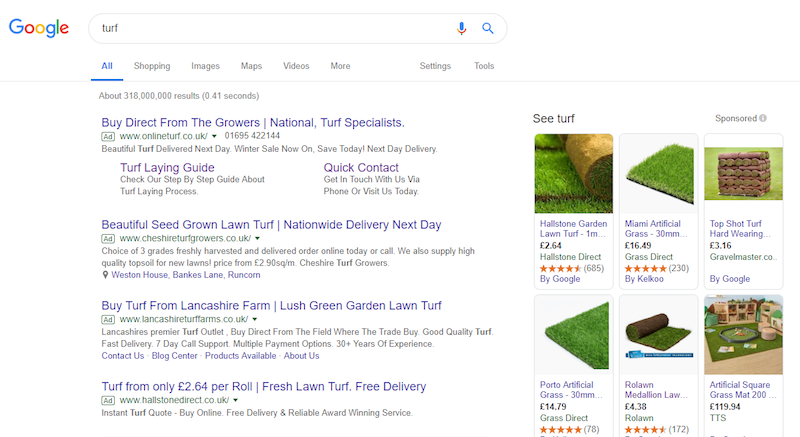
Online Turf values Google advertising because it’s simple to track results.
Google makes it easy for businesses to see the results of their advertising, which is why small businesses prefer it over other online advertising types.
Small Businesses Will Begin Using a Variety of Advertising Mediums in 2019
Many small businesses will begin using new traditional and digital advertising mediums in 2019.
Two-thirds (67%) will start using at least one advertising medium in 2019.

Specifically, small businesses will begin using online (17%), print (15%), event (15%), radio (14%), TV (13%) and social media (12%) advertising in 2019 – and many plan to begin using more than one.

Advertising will continue to be important for businesses to help them stand out from their competition.
“In a world where there’s so much distraction, competition, and noise, you want to be able to tell your story and convey value,” said Robin Raj, founder and executive creative director of Citizen Group, a design and brand management agency in California. “That often requires paid media to put out the content or message you want to convey, and it’s important to continually evolve this strategy and listen to your customers.”
Small businesses need to always be willing to change their advertising strategy based on what mediums are most likely to reach their customers.
Advertising Is Essential for Small Businesses
Although small businesses have limited resources, they should make an effort to advertise.
Most small businesses advertise online, which is more cost-efficient and requires less time and effort than traditional advertising. Traditional mediums, however, are still important in reaching customers when they’re not online.
Two-thirds of small businesses will begin using another new advertising medium in 2019, signaling that they will continue to value advertising.
It’s important for small businesses to advertise to reach customers and help influence their purchasing decisions.
About the Survey
The Manifest surveyed 529 small business owners and managers at companies in the U.S. with fewer than 500 employees.
Fourteen percent (14%) of respondents’ businesses have 1 employee, 40% have 2 to 10 employees, 24% have 11 to 50 employees, 15% have 51 to 250 employees, and 7% have 251 to 500 employees.
Fifty-two percent (52%) of survey respondents are male; 48% are female.
Twenty-nine percent (29%) of respondents are millennials (ages 18-34), 45% are Generation X (ages 35-54), and 27% are baby boomers or older (ages 55+).
Respondents are from the South (44%), Northeast (20%), Midwest (18%), and West (18%).
